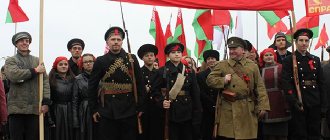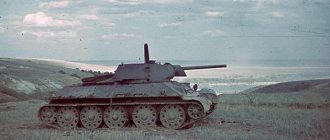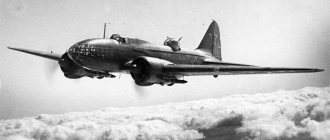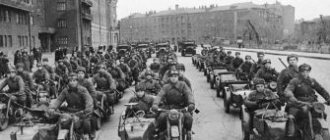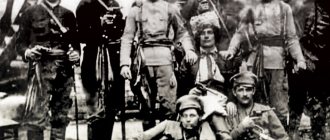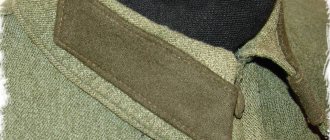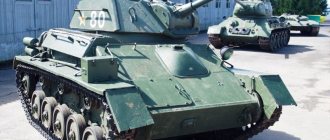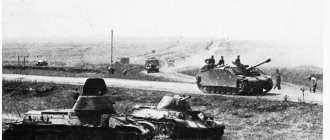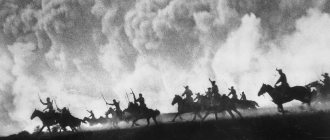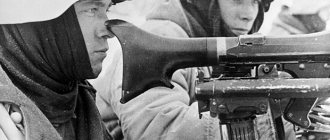The Red Guard owes its birth to the October Revolution of the Bolsheviks. Its first distinctive signs were a red ribbon on its headdress and a red armband with the inscription “Red Guard”. This inscription, as a rule, was made typographically with black paint.
On January 15 (28), 1918, a historic decree was adopted on the organization of the Workers' and Peasants' Red Army. Creating its first detachments, and subsequently a massive, multimillion-strong army in conditions of enormous economic devastation, the Soviet government and command, not being able to provide all the Red soldiers with uniforms, were forced to put up with the fact that the clothing of the Red Army soldiers and commanders was mixed, varied and often low quality. The most common clothing of soldiers and commanders of that time was the uniform of the old army without insignia and random civilian clothing.
Military personnel of the Red Army, Cheka troops, convoy guards and other types of auxiliary troops, as a rule, wore a protective tunic with a standing collar, trousers of the same color, boots or shoes with windings, and a single-breasted military overcoat. In addition, some commanders and political workers had leather jackets and caps, English and American style service jackets. New recruits to the Workers' and Peasants' Red Army were allowed to remain in their own clothes.
On December 15, 1917, the Revolutionary Military Council of the Republic introduced the badge of the Red Army soldier and the Red commander. It was a brass five-pointed star, covered with red enamel and framed with a wreath of laurel and oak branches. In the center of the star was an emblem - a plow and a hammer. This badge was worn on the chest by everyone who was in active service in the Red Army. The same star, but without a wreath, was also attached to the headdress.
Budenovka and overcoat
At the end of 1918, the competition jury and the Revolutionary Military Council of the Republic (RVSR) reviewed projects for new military uniforms. On January 16 and April 8, 1919, orders of the RVSR approved winter headdress, sleeve insignia, buttonhole colors by branch of the military, overcoats, summer shirts, and shoes.
The winter headdress was a helmet of gray cloth with a visor and a folding back plate, which was fastened with leather straps and buttons to the helmet on the left and right sides. A star made of colored cloth was sewn to the front. It was outlined with black paint 5-6 mm wide with a red border. In the center of this star was attached an icon - a cockade - a red star with a plow and a hammer.
The first to wear new hats were the soldiers and commanders of the Ivanovo-Voznesensk detachment led by M.V. Frunze, sent to the Eastern Front, and the First Cavalry Army of S.M. Budyonny.
The shape of the helmet resembled the original Russian protective armor - the iron helmet of a knight, a hero. Therefore, at first it received an unofficial name - bogatyrka, and later - budenovka. The Budenovka helmet became the personification of the high revolutionary impulse of the young Red Army, its devotion to the ideals of the revolution, the ideals of the party. He became a symbol of the great pathos of the revolution and civil war.
The new overcoat went well with the budenovka. It was elegant, simple and comfortable, giving the Red Army soldier the opportunity to look like a folk hero, an epic hero. This was achieved by cutting the overcoat and choosing the color of the cloth and stripes. The overcoat was made from khaki cloth and had 4 pockets - two side and two chest. The collar, cuffs and pocket flaps were made of overcoat cloth, but of a darker color. Three flaps made of colored cloth were sewn on the chest to the left side of the overcoat, the right side of each of them ended with a loop, with which they were fastened to the buttons of the right side of the overcoat. (These stripes in everyday life are called “conversations”). Diamond-shaped buttonholes of colored instrument cloth were sewn onto the ends of the collar. There were two straps along the waistline - on the left and right sides.
A sample of a summer shirt was also installed. It was made from cotton fabric of khaki color. The same flaps as on the overcoat were sewn onto the stand-up collar and chest of the shirt; they consisted of two parts and, when the shirt was buttoned up, formed a single patch. Uniforms and insignia were established centrally.
The summer headdress was a khaki cap with a cockade badge - a red star with a plow and a hammer in the center.
The most difficult thing for the young Soviet government was providing the army with shoes. By Order of the RVSR No. 628 of April 8, 1919, sandals were introduced as footwear for the Red Army. Commanders were allowed to buy boots at their own expense.
Uniforms and insignia of the White armies
Uniforms and insignia of units of the White Army. An example of shoulder straps for the personnel of the Officer Rifle Corps named after. General of the Drozdovsky division.
In this case, arrows. The ranks are the same as in the Imperial Army.
Shoulder straps of the personnel of the Kornilov shock division.
Apparently the Kornilovites have black and white on their flank. These are their brothers, these are the Markovians in a hurry.
The ranks are the same as in the Imperial Army.
Over the short, independent history of Ukraine after 1917, several types of insignia have changed. From the braid on the sleeves to the buttonholes on the collar.
Since I am interested in the period of the Ukrainian State, it looked like this.
Officers' shoulder straps were of two types: ceremonial and field.
The front ones almost completely copied the German ones, and the field ones were of the British type with gaps and zigzags in the Russian manner. However, they had a wedge-shaped shape in both cases. The stars were four-pointed, of the German type from 1 to 3, depending on the specific rank in the length of the shoulder strap. And in the opposite color with galloon on the ceremonial version. The shoulder straps had piping in the color of the branch of service.
General Sergeant Major
The ceremonial shoulder strap is of the German type, but wedge-shaped, rounded at the button. The field shoulder strap had a zigzag like in the Russian army. Stars the length of the shoulder strap, four-pointed.
General sheepskin - three General badge - two General cornet - one.
As for the crossed batons (maces?) on Skoropadsky’s shoulder straps, I cannot say anything. I will only venture to guess that only Skoropadsky had them and this rank was called that way - hetman.
Mace Sergeant Major
The ceremonial shoulder strap was in the German style, the field one had two gaps. The stars were 4-pointed, the length of the shoulder strap.
Colonel - three Troop foreman - two Esaul - one
Sergeant Major
Parade shoulder strap in the German style, one gap on the field. The appearance and arrangement of the stars is the same as that of the mace.
Sotnik - three Badge - two Cornet - one
The sub-sergeant wore a wedge-shaped shoulder strap made of the same material as the jacket. They differed from the field ones only in the color of the cloth. They had edging in the color of the military branch. A specific rank could be determined by the stripes on the shoulder strap.
Bunchuzhny - one wide Chotovy - three narrow Royovy - two narrow Lanky - one narrow. Cossack - clean shoulder straps without stripes.
However, there were problems with the supply of uniforms and not all officers received them. They mostly wore slightly modified Russian uniforms with elements of British, German or Austro-Hungarian ones. The only exception was the hetman's entourage.
Military sailors of the Ukrainian State used galloons on the sleeves of their jackets as a distinction between ranks. Also on a white tunic they wore wedge-shaped shoulder straps of black cloth with galloons according to rank. The upper galloon on the sleeves was crowned with a “trident”. On shoulder straps there is an anchor for officers and a “trident” for admirals. The names of the ranks were completely copied from the Russian Imperial Navy.
Admirals wore one wide braid with a zigzag pattern. Under it, according to the specific rank, were wavy-shaped half-moons.
Admiral - wide + three half braids Vice Admiral - wide + two half braids Rear Admiral - wide + one half braid Captain of the 1st rank had four braids Captain of the 2nd rank - three Senior Lieutenant - two Lieutenant - one braid and two half braids under it Midshipman - one braid and one half-braid underneath. The ship's midshipman had one braid.
Junker
Many students of cadet corps and cadet schools from October 1917 (defense of the Winter Palace and battles in Moscow) voluntarily and consciously participated in the fight against the Bolsheviks. Junkers made their way to the Don in various ways to join Kornilov’s army or Chernetsov’s partisan detachment. All cadets who set out on the 1st Kuban (“Ice”) Campaign were awarded the first officer rank by order of General Kornilov in March 1918. It was difficult to wear the uniform of their school (certain embellishments on shoulder straps and other insignia) and the cadets wore the uniform of the regiments in which they fought.
Soldier in summer field uniform (infantry)
In the Civil War, very few people had protective helmets. The soldiers wore caps, kubankas, hats, wore royal tunics and trousers, or wore civilian shirts and trousers of a wide variety of colors.
Soldier in winter marching uniform
In winter, many soldiers and officers dressed in what they had at hand - overcoats, various short fur coats, bekeshes and even civilian coats.
Cossack
The Don Cossacks actively participated in the anti-Bolshevik struggle along with volunteers in the Volunteer, Don Army, the Armed Forces of the South of Russia and the Russian Army of General Wrangel. Distinctive features of the uniform of the Donets were dark blue trousers with a scarlet stripe, scarlet tops of caps and crowns of caps (with a blue band). Many Cossacks wore forelocks that stuck out from under their caps
Mountain Cossack officer
In the Volunteer Army there were: Circassian Cavalry Regiment (In the 1st Kuban Campaign), Chechen Cavalry Division. The Kuban and Terek Cossacks who fought as part of the Volunteer Army had a uniform similar to the highlanders. These are scarlet or black beshmets, gray or black Circassian coats with gazyrs, hats or kubankas. Burkas were used to protect against the cold. Daggers were rarely worn or used.
Colonel (Dekinets, infantry)
For all ranks of the Volunteer Army, from January 10, 1918, a distinctive sign was established, which was worn on the left sleeve of an overcoat or uniform - an angle of national colors (angled down) an inch (4.4 cm) above the elbow. This corner was a symbol of the struggle for One Indivisible Great Russia.
Second Lieutenant (Kornilovets)
The Kornilov Shock Regiment was formed on the Western Front by Captain Nezhentsev. The distinctive insignia of the Kornilovites were a skull and crossbones and black and red shoulder straps symbolizing the readiness to die for the Motherland and freedom - “better death than the death of Russia.” On the sleeve emblem, crossed swords are a symbol of the army, Granada (bomb) - a symbol of the guards (grenadier) units. Officers of the Kornilov units most often wore a black tunic and trousers with white piping, a cap with a red crown, a black band and white piping.
- Drozdovtsy - rifle units
- Cossacks - Kornilovites
- Annenkovites
- Alekseevtsy
- Orenburg Cossack
- Cossacks of the Wolf Hundred A. Shkuro
- Centurion of the partisan division of Ataman B. Annenkov
- Cornet of Ataman Kalmykov's detachment
- Uniform of the Izhevsk and Votkinsk People's Armies (August-November 1918)
- Battalion banner of the 1st Siberian assault brigade
- Northwesterners
- Partisans - Chernetsovtsy
- Kirigiz of the personal convoy of the ataman of the Orenburg Cossack army Dutov 1919
- Uniform of the Izhevsk and Votkinsk People's Armies (August - November 1918)
- Shoulder strap of a private of the 1st Volga General Kappel rifle regiment (Far Eastern Army), 1920 - 1921.
- Private of the 1st Volga General Kappel Rifle Regiment (Far Eastern Army), 1920 - 1921.
- Drozdovskaya division
- Army of Komuch
- Warrior - volunteer, Zemstvo army, 1922
- Captain of the Volga Artillery Squad, Zemskaya Army, 1922.
- Headquarters - Captain, in a British-style uniform, with insignia by order of the VUSO in 1918.
- Soldier of the Holy Cross squad 1919-1920
- Shoulder straps of the Izhevsk People's Army (August - November 1918)
- Siberian Army (cockade)
- Siberian Army
- Siberian Army
- Siberian Army
- Siberian Army
- Siberian Army
- Siberian Army
- Shoulder strap of the captain of a crew member of an armored car of the Drozdovskaya division
- Shoulder straps of Vladimir Konstantinovich Vitkovsky
- Shoulder straps of Vladimir Konstantinovich Vitkovsky
- Siberian Army
- Siberian Army
- Shoulder straps of the 16th Ishim Siberian Rifle Regiment
- Shoulder straps of the Izhevsk People's Army (August - November 1918)
- Banner of the Votkinsk People's Army (August - November 1918)
- Banner of the Votkinsk People's Army (August-November 1918)
- 1st Siberian Assault Brigade (epaulettes)
- Officer and lower rank of the 25th Yekaterinburg Mountain Rifle Regiment
- Shoulder straps of the 25th Ekaterinburg Mountain Rifle Regiment
- Shoulder straps for ensign and private of the Volunteer Division
- Shoulder straps for lower ranks of artillery of the 4th East Siberian Army Corps
- Drozdovets - artilleryman
Red Army insignia 1919
On January 16, 1919 (Order of the RVSR No. 116), insignia for the official position of commanders and chiefs were introduced for the first time in the Red Army. This made them stand out and raised their authority. Insignia were made from scarlet cloth and sewn over the cuff of the left sleeve of an overcoat and shirt. They consisted of a star and, in addition, for junior commanders - triangles (side length 4 cm), for middle and senior commanders - squares (side length 3 cm) and for senior commanders and commanders - rhombuses (side length 3 and 3.5 cm ). The star and other stripes had a black outline. A hammer and sickle were painted in black in the center of the star.
Ditties about... uniforms!
All this splendor, of course, was complemented by various forms of their own propaganda and agitation, in which the Bolsheviks showed themselves to be unsurpassed masters. In Russia, propaganda trains and propaganda ships were running everywhere, and millions of copies of leaflets, brochures and newspapers were printed disseminating communist ideas. City streets were decorated with red flags and banners, posters and monuments to revolutionaries of all stripes (for example, as part of the anti-religious campaign in August 1918, a monument to... Judas Iscariot was erected in Sviyazhsk!), theatrical performances and rallies were organized. At the same time, the enemy’s uniform often became the object of amateur ditties: Who is painted like a poster? That's Kornilov's soldier! At the same time, the very appearance of a Red Army soldier in a Budyonnovka helmet, the appearance of something like an ancient Russian hero, a man of the people, was very difficult to ridicule. The Whites did not try to do this, but they tried to present the Red Army soldiers as servants of the Antichrist: they say, “as soon as you turn their star over, the horns will start to appear...”. Meanwhile, a Spanish proverb of the 15th century says: “The ax of the king cuts, the fires of the priests burn, but street songs kill faster!”
Photos of the uniform of the Red Army 1918-1936.
| Red Army soldier, 1918 | Red Army soldier, volunteer of the Bashkir Red Army, 1918 | Commissioner, 1918-20 |
| Company commander, 1919 | commander , 1920-22. | Commander of the cavalry division, 1920-22. |
| Infantry shooter in winter camouflage, 1920-21. | Military director of the OGPU Inspectorate, 1923. | Red Army soldier in summer uniform, infantry, 1923-24. |
| Red Army soldier in winter uniform, infantry, 1923-24. | Red Army soldier in summer uniform, infantry, 1924. | Representative of the OGPU leadership in winter uniform. 1924 |
| OGPU employee in everyday uniform, 1924-27. | Assistant Battalion Commander in Field Uniform, Infantry, 1925-26. | Presiding officer of a military tribunal in winter uniform, 1924 |
| Head of the station department of the OGPU. Transport departments of the OGPU, 1925-34. | Assistant commander of a separate squadron, cavalry, 1927-29. | Red Army soldier in field uniform, armored forces, 1931-34 |
| Red Army soldier, cavalry, 1931-36. |
Description of the uniform of the Red Army 1936-43.
Noticeable differences from the army uniform were received by the command staff of the bodies and troops of the NKVD of the USSR, introduced on December 27, 1935. This was preceded by the decision of the Politburo of the Central Committee of the All-Union Communist Party of Bolsheviks of September 10, 1935, according to which all organizations, institutions and individuals were prohibited from wearing uniforms and insignia , similar or similar to the Red Army. However, the situation soon changed, and already on July 15, 1937, by order of the People's Commissar of Internal Affairs, the same uniform was introduced for all NKVD personnel as in the Red Army with minor differences in the cut of some items.
An unusual uniform was introduced on October 27, 1936 for full-time command, teaching staff and students of the newly formed General Staff Academy. The main features of this uniform were a black velvet French collar, tunics and overcoats, white piping and stripes on the trousers. Taking advantage of the fact that the “infantry” crimson color was established for the buttonholes, cap and stripes, those who preferred to save sewing money wore ordinary breeches for infantry command personnel with crimson edging and without stripes when wearing a tunic. This colorful uniform was canceled on May 22, 1940, shortly before the introduction of uniforms for Red Army generals.
Based on the results of the assessment of the military operations against Finland (December 1939 - March 1940), a number of decisions were made to reorganize the military command system in order to ensure clear unity of command. As one of the measures to strengthen the authority of command personnel, on May 7, 1940, general ranks were established for the senior command staff of the Red Army and on July 13, 1940, general uniforms and insignia .
Similar to the uniform of pre-revolutionary Russian generals were: a khaki -colored jacket with breast welt pockets, trousers with stripes, a hat and an edged overcoat with “coat of arms” buttons. The cut of the single-breasted dress uniform was borrowed from the German army. In addition to the above, the generals of the Red Army were entitled to a cap (ceremonial and everyday) with a round gilded cockade, a ceremonial overcoat and a white cotton jacket .
The main insignia were placed on diamond-shaped buttonholes edged with gilded thread. The ranks of combined arms generals (red buttonholes ) were indicated by gilded metal stars, and the ranks of generals of artillery and tank forces (black buttonholes ), as well as aviation (blue buttonholes ), signal troops, engineering troops, technical troops and quartermaster service (crimson buttonholes ), in addition , also with a gilded emblem of the corresponding branch of the military. Marshals of the Soviet Union, when wearing a general's uniform, were entitled to red buttonholes decorated with gold embroidered stars in a hammer and sickle pattern with intersecting laurel branches, gold embroidered sleeve squares (also with laurel branches) and large sleeve stars.
While the senior command staff was preparing to try on the new general uniform, the insignia of the middle and senior command staff were changed. On July 26, 1940, by order of the People's Commissar of Defense, their new description was announced. The gold edging of the buttonholes of commanders, from junior lieutenant to colonel, was now done with gilded thread, and the sleeve insignia of command personnel acquired a brighter appearance: the squares of the new type differed in the number and width of gold braid with gaps and edging made of red cloth.
No less serious attention was paid to increasing the level of responsibility and raising the authority of the junior command level. On November 2, 1940, the People's Commissar of Defense signed an order establishing military ranks for private and junior command personnel and approved the “Regulations on the service of junior command personnel,” which established strict conditions for obtaining corporal and sergeant ranks and contained a detailed description of the new insignia.
The new type of junior command buttonholes, which were supposed to begin wearing on January 1, 1941, were equipped with a narrow red gap in the middle and a yellow metal triangle in the upper corner. On the buttonholes for petty officers, in addition, a narrow gilded braid was sewn parallel to the edging. The signs denoting ranks, starting with “junior sergeant,” were enamel triangles, which previously corresponded to the positions of junior commanders.
By the beginning of 1941, there was a serious need to reduce the variety of uniforms of the Red Army and, most importantly, to revise the standards for clothing supplies for military personnel. In this regard, it was decided to introduce for the supply of personnel uniforms that were not only uniform in color and pattern for all branches of the military, but also universal for the preparation of uniforms that differ in purpose and time of use. Many items were to be abolished - such as open jackets of the Air Force and armored forces, Cossack uniforms - which made the prestige of their branches of the military, but made it difficult to supply and maneuver with supplies. To solve this problem, it was necessary to significantly improve the input form, without advertising all the changes made.
The corresponding order of the People's Commissar of Defense, issued on February 1, 1941, was classified “top secret.” Of all its contents, only the following were made public: the transition to a single color of uniforms, the introduction of new, more popular fabrics, and the gradual introduction of beautiful ceremonial uniforms to supply combat units. The supply standards for commanding and rank and file personnel established for peacetime and wartime were not subject to disclosure. According to these standards, the simple uniform that was to be accumulated by the beginning of the mobilization deployment of the army consisted of: a khaki cap (in winter - a cap with earflaps, model 1940), a tunic with khaki trousers (for ordinary personnel - only a cotton tunic in winter and summer) and a single-breasted dark gray overcoat with hook-and-eye closure. For the winter period, in addition, the following were provided: a short fur coat or a padded jacket with a padded jacket (for the command staff - a fur vest ), cotton trousers, fur mittens and felt boots .
“Red is a dangerous man!”
It is known that a person dressed in bright red not only attracts everyone's attention, but also serves as a sign of danger to many. It’s not for nothing that all modern glamorous women’s magazines do not recommend that girls wear red lingerie on their first intimate date. It is possible that subconsciously wanting to intimidate the enemy, many commanders of the Red Army ordered their soldiers to dress in red, which seemed to contradict all the rules of camouflage. For example, red shirts were worn in the 51st Infantry Division, and in 1919 in Sumy the commandant’s patrol had not only red bands on their caps, but also red caftans and riding breeches. Special detachments of the Crimean Cheka in the same 1919 were in red from head to toe, on which they, however, were wearing high white leggings. According to diplomat G.N. Mikhailovsky, the security officers looked not so much like Red Army soldiers, but like “Red Indians” from a novel or film. Both red and white wore “red revolutionary trousers” - riding breeches and half-breeches. So it turns out that the White Guards’ underestimation of the emblem of their movement did not have the best effect on their conduct of military operations against the Reds. As a result, Russia suffered.
Magazine: Secrets of the 20th Century No. 37, September 2010 Category: Unknown about the known Author: Vyacheslav Shpakovsky
Tags: propaganda, cockade, emblem, war, Civil War, clothing, Secrets of the 20th century, army, Red Army, star, White movement, symbols, agitation, uniform, Budenovka
- Back
- Forward
